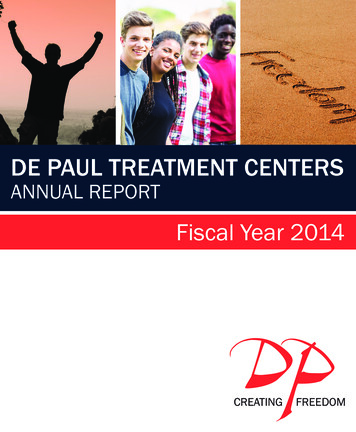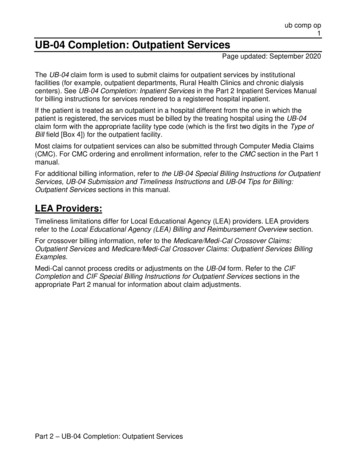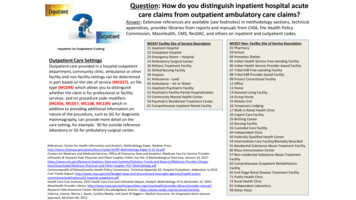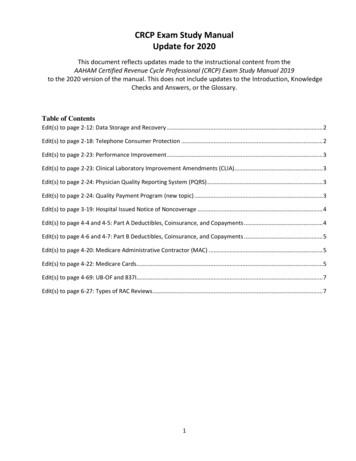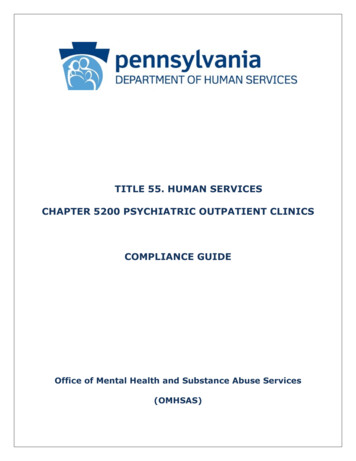
Transcription
The Core Elements ofOutpatient Antibiotic StewardshipNational Center for Emerging and Zoonotic Infectious DiseasesDivision of Healthcare Quality PromotionCore Elements of Outpatient Antibiotic StewardshipCS268900-A1
The Core Elements of Outpatient Antibiotic Stewardship is a publication of The National Centerfor Emerging and Zoonotic Infectious Diseases within the Centers for Disease Control andPrevention.Centers for Disease Control and PreventionNational Center for Emerging and Zoonotic Infectious DiseasesBeth P. Bell, MD, MPH, DirectorSuggested citation:Sanchez, G.V., Fleming-Dutra, K.E., Roberts, R.M., Hicks, L.A. Core Elements of OutpatientAntibiotic Stewardship. MMWR Recomm Rep 2016;65(No. RR-6):1–12.2 Centers for Disease Control and Prevention
Table of ContentsSummary. 4Introduction. 6Background. 7Box 1: Entities that are intended audiences for Core Elements of Outpatient AntibioticStewardship. 9Box 2: Initial steps for antibiotic stewardship: recognize opportunitiesto improve antibiotic prescribing practices by identifying high-priority conditions,identifying barriers to improving antibiotic prescribing, and establishing standardsfor antibiotic prescribing. 10Box 3: Potential partners for outpatient antibiotic stewardship activities. 12Methods. 13Core Elements of Outpatient Antibiotic Stewardship. 15Commitment. 16Action for Policy and Practice. 18Tracking and Reporting. 20Education and Expertise. 23Future Directions. 25Conclusion. 26Acknowledgements. 27References. 27Figure 1. Clinician Checklist for Core Elements of OutpatientAntibiotic Stewardship. 32Figure 2. Facility Checklist for Core Elements of OutpatientAntibiotic Stewardship . 33Core Elements of Outpatient Antibiotic Stewardship 3
SummaryThe Core Elements of Outpatient Antibiotic Stewardship provides a framework forantibiotic stewardship for outpatient clinicians and facilities that routinely provideantibiotic treatment. This report augments existing guidance for other clinical settings.In 2014 and 2015, respectively, CDC released the Core Elements of Hospital AntibioticStewardship Programs and the Core Elements of Antibiotic Stewardship for NursingHomes. Antibiotic stewardship is the effort to measure and improve how antibiotics areprescribed by clinicians and used by patients. Improving antibiotic prescribing involvesimplementing effective strategies to modify prescribing practices to align them withevidence-based recommendations for diagnosis and management.The four core elements of outpatient antibiotic stewardship are commitment, action forpolicy and practice, tracking and reporting, and education and expertise. Outpatientclinicians and facility leaders can commit to improving antibiotic prescribing and takeaction by implementing at least one policy or practice aimed at improving antibioticprescribing practices. Clinicians and leaders of outpatient clinics and health caresystems can track antibiotic prescribing practices and regularly report these data backto clinicians. Clinicians can provide educational resources to patients and families onappropriate antibiotic use. Finally, leaders of outpatient clinics and health systemscan provide clinicians with education aimed at improving antibiotic prescribing andwith access to persons with expertise in antibiotic stewardship. Establishing effectiveantibiotic stewardship interventions can protect patients and improve clinical outcomesin outpatient health care settings.4 Centers for Disease Control and Prevention
Antibiotic stewardship is the effort to measure antibiotic prescribing to improve antibiotic prescribing by cliniciansand use by patients so that antibiotics are onlyprescribed and used when needed to minimize misdiagnoses or delayed diagnosesleading to underuse of antibiotics to ensure that the right drug, dose, and durationare selected when an antibiotic is neededCore Elements of Outpatient Antibiotic Stewardship 5
IntroductionAntibiotic resistance is among the greatest public health threats today, leading to an estimated2 million infections and 23,000 deaths per year in the United States.1 Although antibiotics arelife-saving drugs that are critical to modern medicine, infections with pathogens resistant tofirst-line antibiotics can require treatment with alternative antibiotics that can be expensiveand toxic. Antibiotic-resistant infections can lead to increased health care costs and, mostimportantly, to increased morbidity and mortality.1 The most important modifiable risk factor forantibiotic resistance is inappropriate prescribing of antibiotics. Approximately half of outpatientantibiotic prescribing in humans might be inappropriate, including antibiotic selection, dosing, orduration, in addition to unnecessary antibiotic prescribing.2–4 At least 30% of outpatient antibioticprescriptions in the United States are unnecessary.5Antibiotic stewardship is the effort to measure antibiotic prescribing; to improve antibioticprescribing by clinicians and use by patients so that antibiotics are only prescribed andused when needed; to minimize misdiagnoses or delayed diagnoses leading to underuse ofantibiotics; and to ensure that the right drug, dose, and duration are selected when an antibioticis needed.1,6 Antibiotic stewardship can be used in all health care settings in which antibioticsare prescribed and remains a cornerstone of efforts aimed at improving antibiotic-related patientsafety and slowing the spread of antibiotic resistance. The goal of antibiotic stewardship is tomaximize the benefit of antibiotic treatment while minimizing harm both to individual personsand to communities.6 Centers for Disease Control and Prevention
BackgroundImproving antibiotic prescribing in all health care settings is critical to combating antibioticresistant bacteria.7 Approximately 60% of U.S. antibiotic expenditures for humans are relatedto care received in outpatient settings.8 In other developed countries, approximately 80%–90%of antibiotic use occurs among outpatients.9,10 During 2013 in the United States, approximately269 million antibiotic prescriptions were dispensed from outpatient pharmacies.11 Approximately20% of pediatric visits12 and 10% of adult visits3 in outpatient settings result in an antibioticprescription. Complications from antibiotics range from common side effects such as rashesand diarrhea to less common adverse events such as severe allergic reactions.13 These adversedrug events lead to an estimated 143,000 emergency department visits annually and contributeto excess use of health care resources.13 Antibiotic treatment is the most important risk factorfor Clostridium difficile infection.14 In 2011, an estimated 453,000 cases of C. difficile infectionoccurred in the United States, approximately one third of which were community-associatedinfections (i.e., occurred in patients with no recent overnight stay in a health care facility).15 Asmuch as 35% of adult and 70% of pediatric C. difficile infections are community associated.15,16One study estimated that a 10% reduction in overall outpatient antibiotic prescribing couldreduce community-associated C. difficile infections by 17%.17 By reducing unnecessaryantibiotic prescribing,18–20 antibiotic stewardship can prevent avoidable adverse events resultingfrom antibiotics.In 2014 and 2015, respectively, CDC released the Core Elements of Hospital AntibioticStewardship Programs21,22 and the Core Elements of Antibiotic Stewardship for Nursing Homes.23Core Elements of Outpatient Antibiotic Stewardship 7
This 2016 report, Core Elements of Outpatient Antibiotic Stewardship, provides guidancefor antibiotic stewardship in outpatient settings and is applicable to any entity interested inimproving outpatient antibiotic prescribing and use. The intended audiences for this guidanceinclude clinicians (e.g., physicians, dentists, nurse practitioners, and physician assistants) andclinic leaders in primary care, medical and surgical specialties, emergency departments, retailhealth and urgent care settings, and dentistry, as well as community pharmacists, other healthcare professionals, hospital clinics, outpatient facilities, and health care systems involved inoutpatient care (Box 1).Leaders of organizations of any size and within any medical specialty, from single-providerclinics to large health care systems, are encouraged to commit to optimizing antibioticprescribing and patient safety; implement at least one action in the form of a policy or practiceto improve antibiotic prescribing; track and regularly report antibiotic prescribing practices toclinicians or enable clinician self-assessment on antibiotic prescribing; educate clinicians andpatients on appropriate antibiotic prescribing; and ensure access to expertise on antibioticprescribing. Before implementing antibiotic stewardship interventions, clinicians and outpatientclinic and health system leaders can identify opportunities to improve antibiotic prescribing.These opportunities include identifying high-priority conditions for intervention, identifyingbarriers that lead to deviation from best practices, and establishing standards for antibioticprescribing based on evidence-based diagnostic criteria and treatment recommendations(Box 2). High-priority conditions are conditions for which clinicians commonly deviate frombest practices for antibiotic prescribing and include conditions for which antibiotics areoverprescribed, underprescribed, or misprescribed with the wrong antibiotic agent, dose, orduration. Barriers to prescribing antibiotics appropriately might include clinician knowledge gapsabout best practices and clinical practice guidelines, clinician perception of patient expectationsfor antibiotics, perceived pressure to see patients quickly, or clinician concerns about decreasedpatient satisfaction with clinical visits when antibiotics are not prescribed. Standards forantibiotic prescribing can be based on national clinical practice guidelines by national healthcare professional societies such as the American Academy of Pediatrics, the American Collegeof Physicians, or the Infectious Diseases Society of America or, if applicable, can be based onfacility- or system-specific clinical practice guidelines. A summary of current national clinicalpractice guidelines for common outpatient infections in children and adults is available tpatient-hcp/index.html.Clinicians and clinic leaders can collaborate with relevant partners in the broader healthcare community to facilitate outpatient antibiotic stewardship (Box 3). To improve antibioticprescribing, clinic leaders can implement effective strategies to modify prescribing behaviorsand align them with evidence-based recommendations for diagnosis and management.1Clinicians can expect outpatient antibiotic stewardship to improve the quality of patient care,slow the development of community antibiotic resistance, and reduce avoidable adverse drugevents caused by unnecessary use of antibiotics.24,258 Centers for Disease Control and Prevention
Box 1. Entities that are intended audiences for Core Elements of OutpatientAntibiotic StewardshipEntities that are intended audiences for this report are outpatient health care professionalsand leaders of their respective clinics, departments, facilities, and health care systems.Primary care clinics andcliniciansThese clinics and cliniciansprescribe approximately half ofall outpatient antibiotics in the United States.* Thisincludes clinicians specializing in family practice,pediatrics, and internal medicine, all of whomtreat a wide variety of patients and conditions thatmight benefit from antibiotic treatment.Outpatient specialty andsubspecialty clinics and cliniciansThese clinics and clinicians focuson treatment and managementof patients with specialized medical conditionsthat sometimes benefit from antibiotic therapy.These specialties clinics include gastroenterology,dermatology, urology, obstetrics, otolaryngology,and others.Emergency departments (EDs)and emergency medicinecliniciansEDs and emergency medicineclinicians are positioned between acute carehospitals and the community and encounter uniquechallenges, including lack of continuity of careand higher concentration of high-acuity patients,as well as unique opportunities for stewardshipinterventions, such as greater clinician accessto diagnostic resources and the expertise ofpharmacists and consultants.Retail health clinics and cliniciansThese clinics and clinicians providetreatment for routine conditionsin retail stores or pharmacies andrepresent a growing category of health care delivery inthe United States.Dental clinics and dentistsDental clinics and dentists useantibiotics as prophylaxis beforesome dental procedures and fortreatment of dental infections.Nurse practitioners andphysician assistantsThese clinicians work in everymedical specialty and subspecialtyinvolved in antibiotic prescribing and should beincluded in antibiotic stewardship efforts.Urgent care clinics and cliniciansThese clinics and cliniciansspecialize in treating patients whomight need immediate attention orneed to be seen after hours but might not need to beseen in EDs.Health care systemsHealth care systems plan, deliver,and promote health care servicesand often involve a network ofprimary and specialty outpatient clinics, urgent carecenters, EDs, acute care hospitals, and other facilitiesthat provide health care services. Health care systemscan use existing antibiotic stewardship programs ordevelop new ones to promote appropriate antibioticprescribing practices in their outpatient facilities aswell as across the system.*Source: CDC. Outpatient antibiotic prescriptions—United States, 2013. Atlanta, GA: US Department of Health and Human Services, CDC; nual-reportsummary 2013.pdfCore Elements of Outpatient Antibiotic Stewardship 9
Box 2. Initial steps for antibiotic stewardship: recognize opportunities to improve antibioticprescribing practices by identifying high-priority conditions, identifying barriers toimproving antibiotic prescribing, and establishing standards for antibiotic prescribingIdentify one or more high-priority conditions for intervention.High-priority conditions are conditions for which clinicians commonly deviate from best practicesfor antibiotic prescribing and include conditions for which antibiotics are overprescribed,underprescribed, or misprescribed with the wrong antibiotic agent, dose, or duration.Examples of types of high-priority conditions for improving antibiotic prescribing include: conditions for which antibiotics are overprescribed, such as conditions for which antibioticsare not indicated (e.g., acute bronchitis, nonspecific upper respiratory infection, or viralpharyngitis).* conditions for which antibiotics might be appropriate but are overdiagnosed, such asa condition that is diagnosed without fulfilling the diagnostic criteria (e.g., diagnosingstreptococcal pharyngitis and prescribing antibiotics without testing for group AStreptococcus).† conditions for which antibiotics might be indicated but for which the wrong agent, dose,or duration often is selected, such as selecting an antibiotic that is not recommended(e.g., selecting azithromycin rather than amoxicillin or amoxicillin/clavulanate for acuteuncomplicated bacterial sinusitis).§ conditions for which watchful waiting or delayed prescribing is appropriate but underused(e.g., acute otitis media or acute uncomplicated sinusitis).¶ conditions for which antibiotics are underused or the need for timely antibiotics is notrecognized (e.g., missed diagnoses of sexually transmitted diseases or severe bacterialinfections such as sepsis).Identify barriers that lead to deviation from best practices.These might include clinician knowledge gaps about best practices and clinical practiceguidelines, clinician perception of patient expectations for antibiotics, perceived pressure to seepatients quickly, or clinician concerns about decreased patient satisfaction with clinical visitswhen antibiotics are not prescribed.Establish standards for antibiotic prescribing.This might include implementation of national clinical practice guidelines and, if applicable,developing facility- or system-specific clinical practice guidelines to establish clear expectationsfor appropriate antibiotic prescribing10 Centers for Disease Control and Prevention
*Sources:Shulman ST, Bisno AL, Clegg HW, et al. Clinical practice guideline for the diagnosis and management of group A streptococcal pharyngitis: 2012update by the Infectious Diseases Society of America. Clin Infect Dis 2012;55:1279–82;Harris AM, Hicks LA, Qaseem A; High Value Care Task Force of the American College of Physicians;CDC. Appropriate antibiotic use for acute respiratory tract infection in adults: advice for high-value care from the American College of Physiciansand the Centers for Disease Control and Prevention. Ann Intern Med 2016;164:425–34;Hersh AL, Jackson MA, Hicks LA; American Academy of Pediatrics Committee on Infectious Diseases. Principles of judicious antibiotic prescribingfor upper respiratory tract infections in pediatrics. Pediatrics 2013;132:1146–54.Source:†Shulman ST, Bisno AL, Clegg HW, et al. Clinical practice guideline for the diagnosis and management of group A streptococcal pharyngitis: 2012update by the Infectious Diseases Society of America. Clin Infect Dis 2012;55:1279–82.Sources:§Chow AW, Benninger MS, Brook I, et al; Infectious Diseases Society of America. IDSA clinical practice guideline for acute bacterial rhinosinusitis inchildren and adults. Clin Infect Dis 2012;54:e72–112;Wald ER, Applegate KE, Bordley C, et al; American Academy of Pediatrics. Clinical practice guideline for the diagnosis and management of acutebacterial sinusitis in children aged 1 to 18 years. Pediatrics 2013;132:e262–80;Rosenfeld RM, Piccirillo JF, Chandrasekhar SS, et al. Clinical practice guideline (update): adult sinusitis executive summary. Otolaryngol Head NeckSurg 2015;152:598–609.¶Sources:Lieberthal AS, Carroll AE, Chonmaitree T, et al. The diagnosis and management of acute otitis media. Pediatrics 2013;131:e964–99;Wald ER, Applegate KE, Bordley C, et al; American Academy of Pediatrics. Clinical practice guideline for the diagnosis and management of acutebacterial sinusitis in children aged 1 to 18 years. Pediatrics 2013;132:e262–80;Rosenfeld RM, Piccirillo JF, Chandrasekhar SS, et al. Clinical practice guideline (update): adult sinusitis executive summary. Otolaryngol Head NeckSurg 2015;152:598–609.Core Elements of Outpatient Antibiotic Stewardship 11
Box 3. Potential partners for outpatient antibiotic stewardship activitiesAcute care hospitalsAcute care hospitals are a critical component of the continuum of care and often share patientswith outpatient clinics. Information sharing between outpatient facilities and acute care hospitals isnecessary to monitor local patterns of antibiotic resistance, minimize duplicative testing, facilitateproper patient transition across different care settings, and collaborate on quality improvementinitiatives. In addition, hospital-based antibiotic stewardship programs might be a resource forexpertise in outpatient antibiotic stewardship initiatives.Long-term care facilitiesLong-term care facilities provide various services, such as medical and personal care, to patients whoare unable to manage independently in the community. Long-term care facilities include rehabilitationfacilities, nursing homes, and long-term acute care facilities. Residents of long-term care facilities alsoare often treated by outpatient clinicians, including medical specialists. Thus, communication betweenoutpatient clinicians and long-term care facilities is critical to antibiotic stewardship efforts.State and local health departmentsState and local health departments play a crucial role in promoting outpatient antibiotic stewardshipby sharing educational resources, connecting local stakeholders and coalitions, designating staffmembers to improve coordination within and across health care facilities, tracking and reporting localantibiotic resistance threats, and promoting infection prevention and vaccinations.Health plans and payers (health insurance companies)Health plans and payers can be a crucial source of data for clinician performance on quality measuresfor appropriate prescribing, including the Healthcare Effectiveness Data and Information Set (HEDIS)measures. In addition, health plans can provide incentives for antibiotic stewardship through qualitybased payments.Health care professional societiesHealth care professional societies provide an important network of health care professionals andhealth care leaders to create and share clinical practice guidelines for diagnosis and managementof common conditions, provide continuing medical education opportunities for members, and bolsternational, local, and regional initiatives promoting appropriate antibiotic use.Community pharmacies and pharmacistsCommunity pharmacies and pharmacists are a trusted source of health care information and providepatient recommendations for nonprescription medications to alleviate symptoms, facilitate medicationtherapy management, screen patients for drug interactions and allergies, and educate patientsregarding appropriate antibiotic use and anticipated side effects. Pharmacies frequently are locatednear clinics in which patients are seen for management of common infections.Local microbiologic laboratoriesLocal microbiologic laboratories can produce regional or local antibiograms (i.e., tables displayingselected antibiotic sensitivities of bacterial species identified from clinical specimens) relevant to thesetting of care, streamline testing and reporting of clinical samples, support rapid diagnostic testing,and provide expertise for interpretation of microbiologic tests.Other important partners in outpatient stewardship include academic institutions, health professional training programs,information technology and electronic medical record software personnel, consumer advocacy groups, pharmaceuticalcompanies, and health sciences education programs.12 Centers for Disease Control and Prevention
MethodsCDC’s Core Elements of Outpatient Antibiotic Stewardship were developed through acombination of consolidating evidence-based antibiotic stewardship practices and buildingon or adapting known best practices for antibiotic stewardship across other clinical settings,such as the core elements outlined for hospitals21,22 and nursing homes.23 A narrative review ofevidence on outpatient antibiotic stewardship interventions, policies, and practices through May2016 was conducted. A systematic review was not conducted because at least five systematicreviews on outpatient stewardship interventions have been performed since 2005,24–28 of whichthe two most recent were published in 2015 and 2016.24,25 The narrative review included thefive systematic reviews,24–28 articles found through in-text citations, and new articles from asupplemental search of articles published during October 2015–May 2016. Information fromselected citations included in the systematic reviews also was considered if it had not beenspecified previously in the systematic review. The supplemental search of PubMed identifiedEnglish-language articles only published during October 2015–May 2016 with the followingsearch terms: “antibiotic stewardship” or “antibiotic prescribing” or “antibiotic prescriptions”or “antimicrobial stewardship” or (“antibiotic” and “stewardship”) or (“antimicrobial” and“stewardship”). Articles identified through these methods were prioritized and included on thebasis of relevance to outpatient antibiotic stewardship, defined as having (1) clearly stated studyobjectives to identify factors affecting outpatient antibiotic prescribing or to assess one or moreoutpatient antibiotic stewardship interventions, (2) been performed in outpatient settings similarto those common in the United States (e.g., study settings in which patients access antibioticsthrough prescriptions written by a clinician), (3) effectively reported outcomes related to antibioticstewardship, (4) enrolled subjects with outpatient infections common in the United States, or (5)Core Elements of Outpatient Antibiotic Stewardship 13
been previously cited as archetypal studies for stewardship interventions rescribing/interventions/index.html); included studies areavailable online (https://stacks.cdc.gov/view/cdc/41536). When no peer-reviewed evidencewas available, expert opinion was substituted.CDC identified subject-matter experts in outpatient antibiotic stewardship research,implementation, policy, and practice on the basis of peer-reviewed publications withrepresentation from important outpatient specialties. Subject-matter experts were identifiedwith expertise in pediatrics, internal medicine, family medicine, emergency medicine, infectiousdiseases, and pharmacy. CDC provided eight subject-matter experts with a draft of the coreelements in April 2016. Subject-matter experts were asked for specific feedback on thefeasibility, acceptability, recommended supplementary materials, and potential for the coreelements to promote effective and meaningful improvements in outpatient antibiotic prescribing.In addition to written feedback via electronic correspondence, a 1-hour group teleconferencewas offered to all subject-matter experts, during which verbal feedback from each person wascollected. CDC revised and refined the core elements using individual feedback received fromthe subject-matter experts.14 Centers for Disease Control and Prevention
Core Elements ofOutpatient Antibiotic StewardshipThe Core Elements of Outpatient Antibiotic Stewardship follow and are summarized in a clinicianchecklist (Figure 1) and a facility checklist (Figure 2):CommitmentDemonstrate dedication to and accountability for optimizingantibiotic prescribing and patient safety.Action for policy and practiceImplement at least one policy or practice to improveantibiotic prescribing, assess whether it is working, andmodify as needed.Tracking and reportingMonitor antibiotic prescribing practices and offer regularfeedback to clinicians, or have clinicians assess their ownantibiotic prescribing practices themselves.Education and expertiseProvide educational resources to clinicians and patientson antibiotic prescribing, and ensure access to neededexpertise on optimizing antibiotic prescribing.Core Elements of Outpatient Antibiotic Stewardship 15
CommitmentA commitment from all health care team members to prescribe antibiotics appropriately andengage in antibiotic stewardship is critical to improving antibiotic prescribing. Every personinvolved in patient care, whether directly or indirectly, can act as an antibiotic steward. Eachclinician can make the choice to be an effective antibiotic steward during each patient encounter.Clinicians can demonstrate commitment to appropriate antibiotic prescribing by doingthe following:Write and display public commitments in support of antibioticstewardship.For example, inappropriate antibiotic prescriptions for acute respiratory infectionswere reduced after clinicians displayed, in their examination rooms, a postershowing a letter from the clinician to their patients committing to prescribingantibiotics appropriately.18 This approach also might facilitate patient communicationabout appropriate antibiotic use.16 Centers for Disease Control and Prevention
Outpatient clinic and health care system leaders can commit to promoting appropriateantibiotic prescribing by doing any of the following:Identify a single leader to direct antibiotic stewardship activities withina facility.Appointing a single leader who is accountable to senior facility leaders isrecommended for hospital stewardship programs,21,22 and this approach also mightbe beneficial in outpatient settings.Include antibiotic stewardship-related duties in position descriptions orjob evaluation criteria.These duties can be listed for medical directors, nursing leadership positions, andpract
Stewardship Programs and the Core Elements of Antibiotic Stewardship for Nursing Homes. Antibiotic stewardship is the effort to measure and improve how antibiotics are prescribed by clinicians and used by patients. Improving antibiotic prescribing involves implementing effective strategies to modify prescribing practices to align them with



